
Irish Language Grammar, New Update
Yesterday we commented on our blog in Irish about the new update to the official Irish grammar standard “An Caigdeán Oifigiúil”.
Our managing director, Damian Scattergood was interviewed on TG4, Ireland’s premier Irish language TV station about this review for the program 7 lá. The program is due to be aired next Tuesday 18th at 7:30 on TG4.
Here is his take on the latest review in English:
Also available in Irish.
What is An Caighdeán?
“An Caighdeán Oifigiúil” as it is called is the official standard for Irish grammar first published in 1958. All Irish translators must follow this if they translate for the government.
Why was the caighdeán updated?
The caighdeán was updated because of the demand for simplicity and consistency of the language.
To explain this historically there are 3 main dialects of Irish coming from Ulster, Munster and Connaught .
So for official government communication it made sense to have a single standard.
The first modern standard “An Caighdeán Oifigiúil” was published in 1958 . It hasn’t been updated since then.
However there have been many new grammar books and dictionaries published that clarified or added to the original Caighdeán standard.
In my opinion I think there were aspects of grammar that were left unclear or were unaddressed. Also some parts where not widely accepted. So a review was needed.
Language is a living thing so it changes over time. With time it grows. Socially a language will change, new words are defined and how it is used on a daily basis by people also changes. So it’s important for any standard to match the social changes.
For example one issue that arose is that some grammar books over the period started to contradict each other. So the review was needed to clarify some areas.
Did it have to be updated?
Yes, overall I think it was necessary for reasons of clarity to allow the language to grow.
More people are actively using the language. We translate into over 50 languages and last year Irish was the third most popular language for us. It accounted for 10% of our business. We see this growing. Since Irish became an officially recognised in Europe a few years ago we have seen more requests for translation coming from places like Germany etc.
So it is important to keep our level of Irish quality high to meet modern European standards. A review like this is probably something that should be done on an on-going basis.
Does it make any difference to STAR?
On a day to day business basis it does not have any major impact for us. We have very strict quality guidelines already in place for our translation.
The positive aspect of the update is that it actually clarifies and extends the original standard. This extension means that the majority of our previous translation work already is perfect. Probably in some ways it will make it easier for us moving forward.
For our translation teams on the ground it is very much the same. The new Caighdeán should make their work a little easier as a result of the clarifications. Some internal debates we would have had around styles etc are now solved.
What does it do for us?
My understanding is that it broadens the grammatical usage that is permitted.
So I think the people that it affects the most are probably native speakers whose dialectic differences were not recognized up until now. As a translator it broadens the grammatical forms that we can use in our translations.
Other than that it does not affect the translators greatly. It just gives more options in how you can translate things in standard Irish.
This review delivers 2 key elements:
- It clarifies elements of the language
- It extends the language, all of which is a great foundation for growth in usage
What does STAR do?
STAR Translation provides translation services into over 50 languages such as Irish, French, Chinese, Arabic etc.
We work with government, public sector and private companies to help them communicate worldwide. We work with many government departments here in Ireland providing document and website translation services.
For us quality is very important. We are certified to both ISO 9001 and EN 15038 — standards are very important to us. We have been working with the Caighdeán since we started translation in 2001.
Why is this important to the language?
As I’ve said previously all language is a moving living thing. Social usage, how people speak changes over time. New words come in, old words go out. How we say and phrase things also change. If you review a textbook in Irish from 1912 it will be very different from one in 1950. Over the last few years we have seen a number of government initiatives around terminology such as focail.ie to help the language keep up with new technology for example. So should you say Fón or Gúthan Phoca for example. Words are just the building blocks for sentences. All of which are important to the way we communicate. So where Focail.ie has updated the words and phrases we use, the Caighdeán clarifies how we take build and extend our language. You need both to continue to grow.
How do you see the Irish language developing?
I’d like to see more of this type of review on an on-going basis.
Today we are seeing a more modern Irish culture growing. The focus on Europe and the single economy I believe is making the younger generation evaluate what it means to be Irish. On one hand people believe we are losing our Irish, but on the other hand the re-evaluation is helping change and grow the language. Irish is more integrated in you younger culture. You can see this in TV, Radio and other media nowadays. There are “Cool” programs now being produced.
The use of a bit of Irish, is becoming natural and part of everyday life for the younger generation. The old strict focus on Irish that we had in our school days is long gone. The Irish language is now considered part of being Irish and who we are instead of just something we had to learn. There is a lot of new technology out there speaking Irish – Websites to learn the language, Apps to download etc.
The modern Irish Social IT culture is certainly proud or where they have come from and their language. I see this continuing to grow. I believe Irish is changing for the better.
